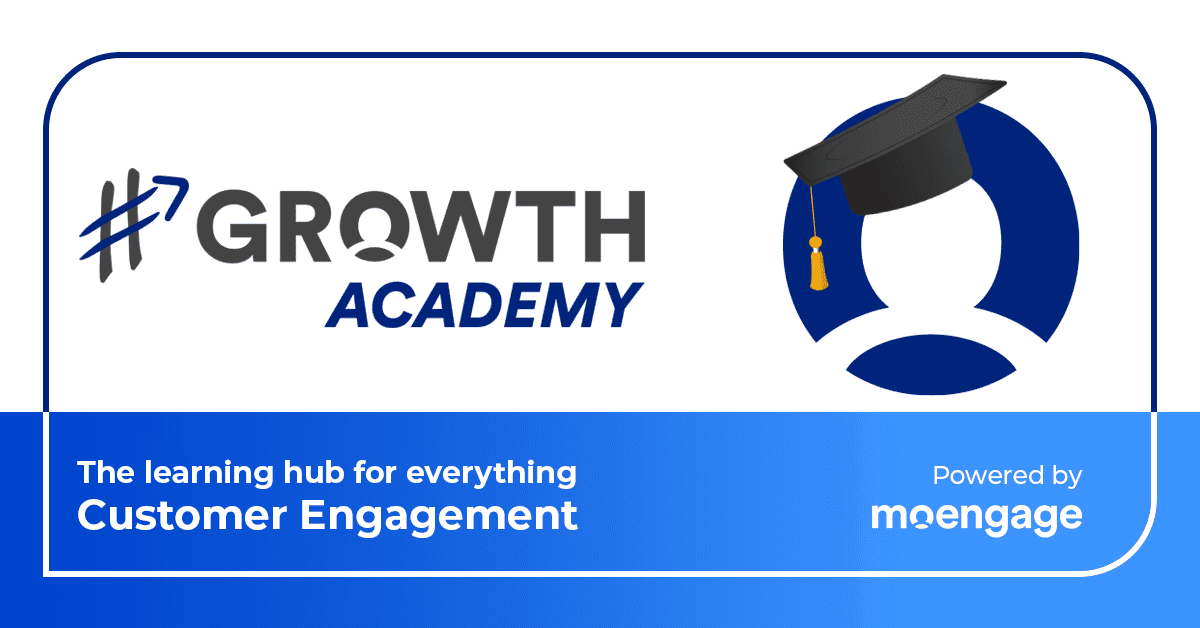Mastering the Art of B2C Personalization and Building Relevant Micro-moments
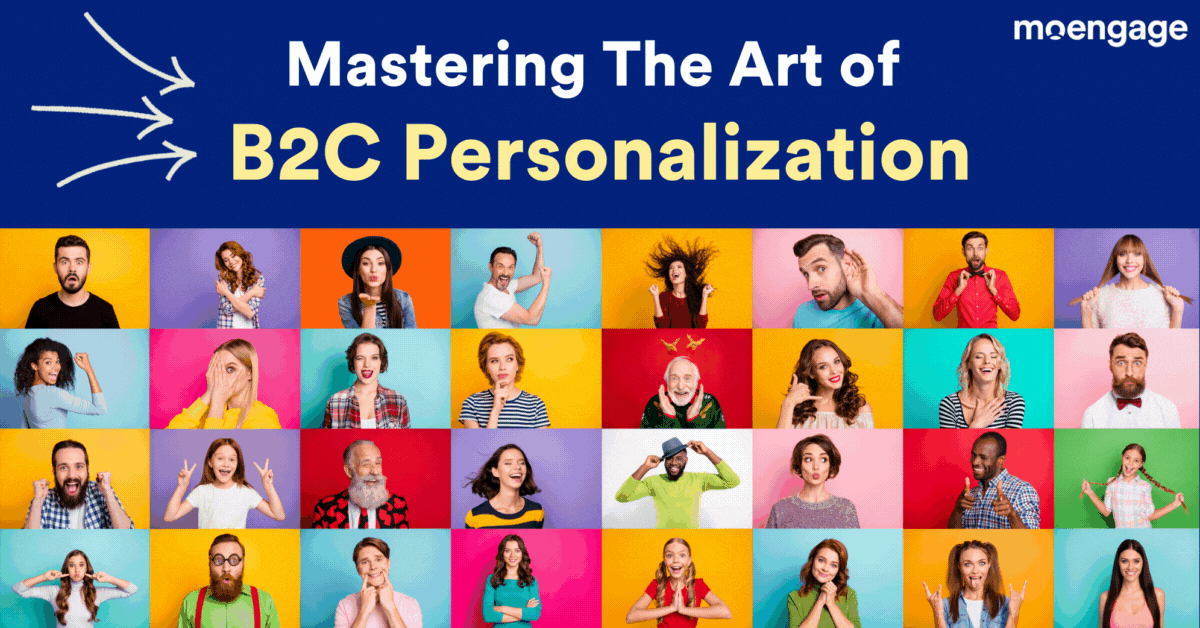
Reading Time: 10 minutes
When communicating with the 21st-century consumer, going ‘personal’ makes all the difference. The adoption of B2C Personalization has picked up rapidly in different consumer markets with many B2C brands using AI-backed marketing tools to ensure their messaging is relevant. Consumer brands are also increasingly using data-driven decisions to build relevant micro-moments inside and outside their digital platforms.
Nothing turns off consumers more than irrelevant messages. In fact, sending an irrelevant message does more harm than no communication at all.
B2C Personalization statistics 2023
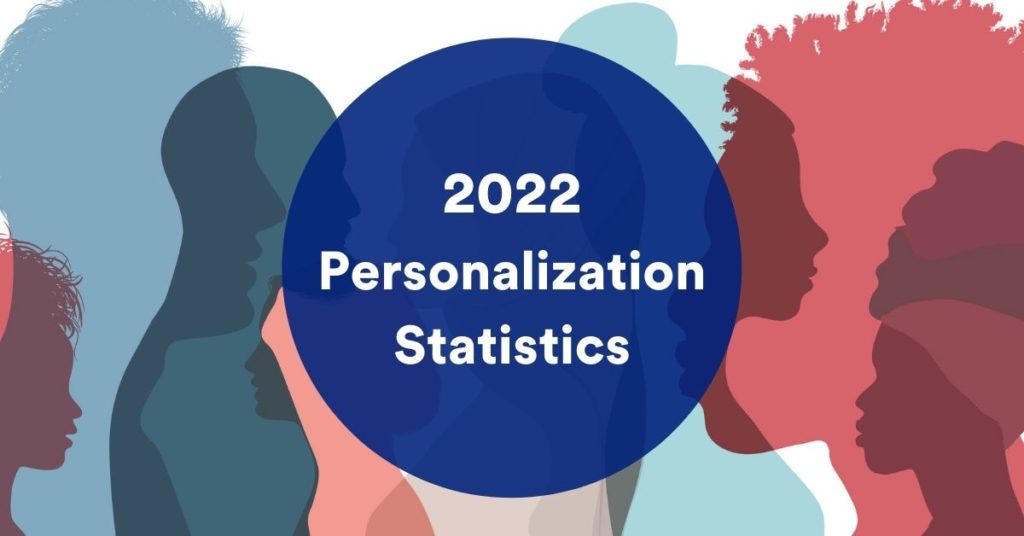
- Personalization boosts Push Notification Click-through Rates (CTR) by more than 1.65X for audio and video streaming mobile apps (source)
- Relevant and personalized communication uplifts conversion rates by up to 1.91X for Media & Entertainment brands (source)
- E-commerce and Retail brands in India have witnessed up to a 100% increase in personalized Push Notification CTRs versus generic broadcasts (source)
- In Southeast Asia, brands in the online shopping sector have successfully boosted conversion rates by 1.2X after implementing personalization and sending relevant messages (source)
- In the Indian market, B2C personalization boosts conversion rates by 2X in the Travel & Hospitality sector (source)
- Travel & Hospitality brands in Southeast Asia have seen up to a 21% uplift in Push Notification CTRs thanks to personalization (source)
- 27% of consumers in North America and Europe get frustrated when brands send inconsistent messaging on different channels (source)
- 26% of Americans and Europeans want B2C brands to personalize their experience based on their purchase history (source)
Insights on B2C Personalization from Monica Shrivastava, the Senior Product Manager at BYJU’s
We invited Monica Shrivastava from BYJU’s to share her thoughts and expertise on personalization for consumer brands. For those out of the loop, BYJU’s is an Edtech unicorn from India with close to 3.5 million paid subscribers and 45 million free users.
Here are a few takeaways from our conversation:
- The primary business metric that personalization has improved is engagement.
- BYJU’s approach to content recommendations: Instead of making cohorts on hunches or “gut-feeling”, the engagement team at BYJU’s relies on user data. One such data point is the format of the content consumed most recently. The recommendation algorithm then uses this information to show content in the preferred format for each customer.
- Building personalized micro-moments: In an attempt to build relevant micro-moments, the BYJU’s team builds personalized performance reports for each student. This report highlights each student’s strengths, areas of improvement, and in-app behavior (what courses or tests have been completed). This approach goes beyond “first-name” personalization.
- Focus areas when it comes to Personalization: According to Monica, the three primary areas that B2C brands need to focus on are – regular input of fresh data and preferences, measuring the impact of personalization the right way, and focussing on both quantitative and qualitative customer data.
- B2C Personalization at scale: Monica mentions that while scaling, the cohorts you’re creating should have bounded rationalities. She also adds that the key to developing scalable personalization solutions is looking at data in an objective way. Lastly, she also mentions the importance of understanding the difference between personalization and invasion of privacy.
You can watch the entire session below:
Learning where to draw the line
There is a fine line between being relevant and being creepy. Consider the three messages below:
| Message | Reaction |
| Summer sale is on! Check out our new collection of summer clothing for you! | 😒 |
| Hey Jessica, here is a playlist we’ve curated for you to beat the Monday blues! | 😃 |
| Hi Adam, since you’re a newlywed pilates instructor staying in San Francisco, love cartoons, and are into parenting blogs, this news piece will interest you!* | 😡 |
* yes Signal, we read your blog 🙂
If you’re nodding your head at the response for each message, then you’ve rightly identified the line between personalization and privacy invasion.
The Personalization Paradox
Consumers hate receiving irrelevant communication and recommendations. At the same time, consumers are wary about sharing their data with brands – information that is used by marketers to build relevant customer experiences and send personalized messages. This conundrum that B2C marketers face is called Personalization Paradox.
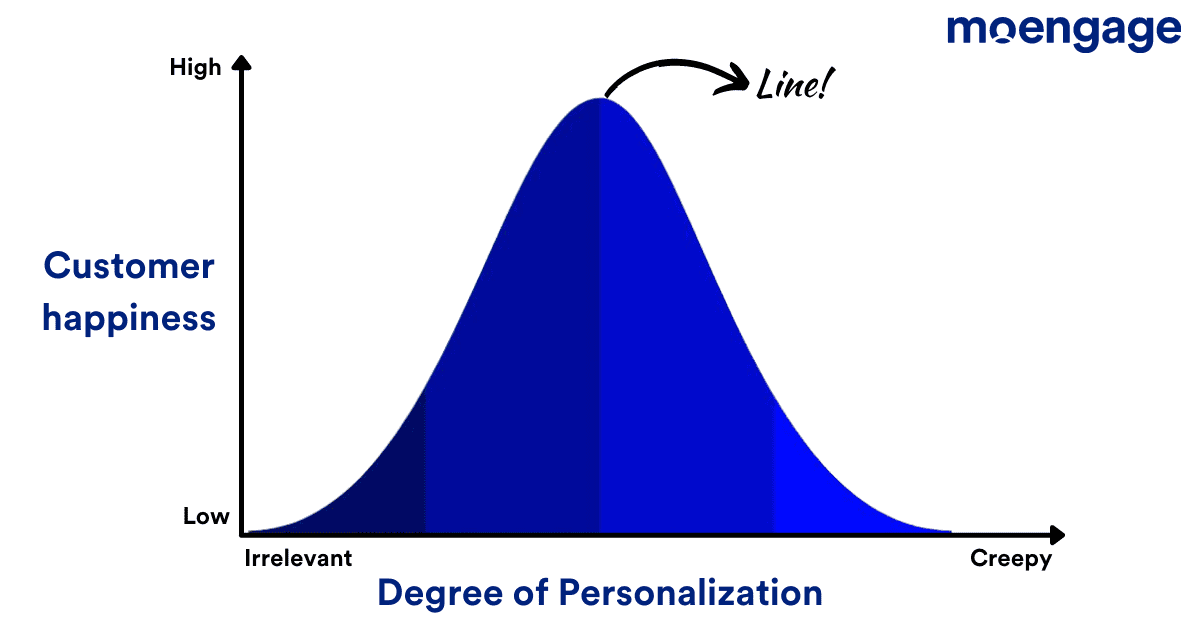
Customer happiness increases as you build more relevant micro-moments and personalize your messages. But once you cross a certain threshold (the line) by increasing the degree of personalization, your customers start considering you as an invader of their privacy.
NOTE: The line will vary for different brands in different consumer verticals and geographies. To identify where the line is for your brand, you have to test out multiple hypotheses by running A/B tests and experiments!
B2C Marketers need to get better at educating their customers around privacy, data collection, and personalization. Consumers eagerly look forward to understanding how their data is being used and what benefits they’re getting by sharing this valuable information. Marketers in consumer brands need to learn to highlight the value exchange in this process and how the data is being used to provide personalized experiences and building relevant micro-moments.
Regulations like the General Data Protection Regulation (GDPR) in Europe and the California Consumer Privacy Act (CCPA) in the United States help marketers understand where to draw the line between personalization and privacy invasion.
I’m sure most of you remember the backlash Facebook-owned WhatsApp received when they tried to force new privacy changes on its customers. We captured the six most important learnings about personalization versus privacy from that fiasco into a blog post.
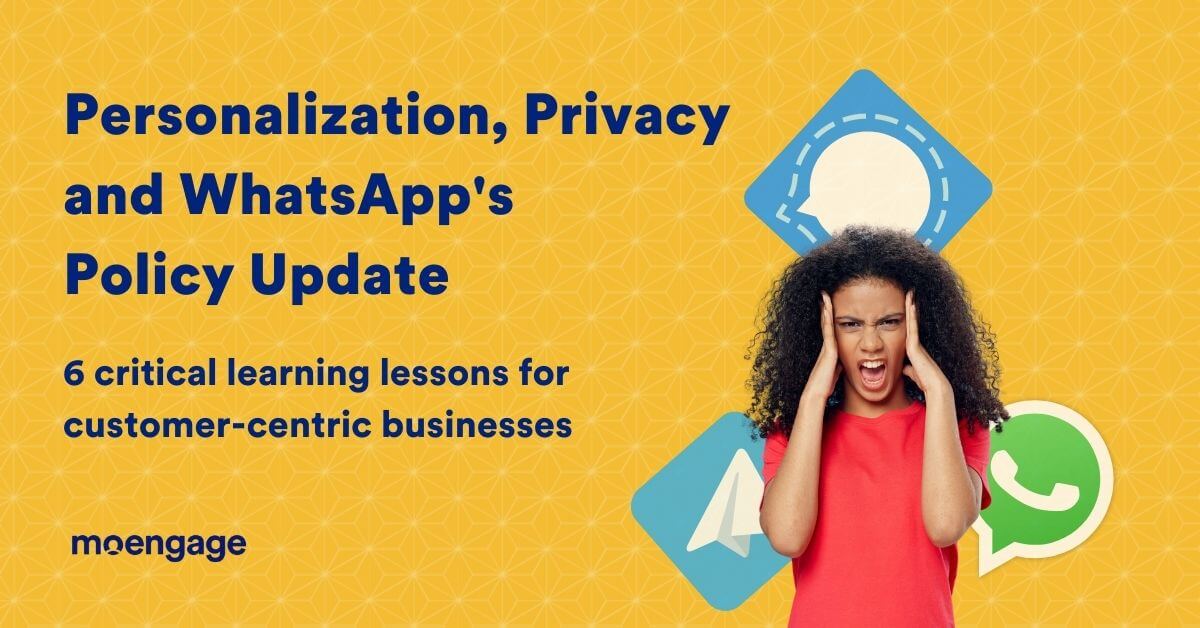
👉 Read more about personalization and privacy from Whatsapp’s controversial privacy changes
To address the issue of when personalization is too little or too much, we had invited leaders from Customlytics, Berlin Brands Group, Delivery Hero, and Project A to share their thoughts. You can view this exciting session below:
B2C Personalization Pulse Check ReportWe recently conducted a survey in the United States, Canada, the United Kingdom, and Germany to understand what consumers think about personalization. We’re working on putting all our insights into a comprehensive report which will highlight:
|
Advanced user segmentation leads to hyper-personalization
The key to effective B2C personalization is segmentation.
Most consumer brands have basic user segments personalization based on demographics and properties like geolocation, gender, age group, or mobile OS. Some consumer brands also consider user behavior to create user segments like frequency of use, the number of transactions, or brand interaction.
The idea behind segmenting users is to provide a personalized experience instead of generic and spammy communication. As a B2C marketer, you can create advanced segments by taking into consideration both demographics and the behavior of your customers.
For example, using RFM models, you can identify all your loyal customers (based on Recency, Frequency, Monetary values, or a combination of all) and then show them a prompt on an in-app interstitial to rate your app on the App Store or the Play Store depending on the mobile OS. Based on your customers’ language preferences, you can also put this message up in different languages.
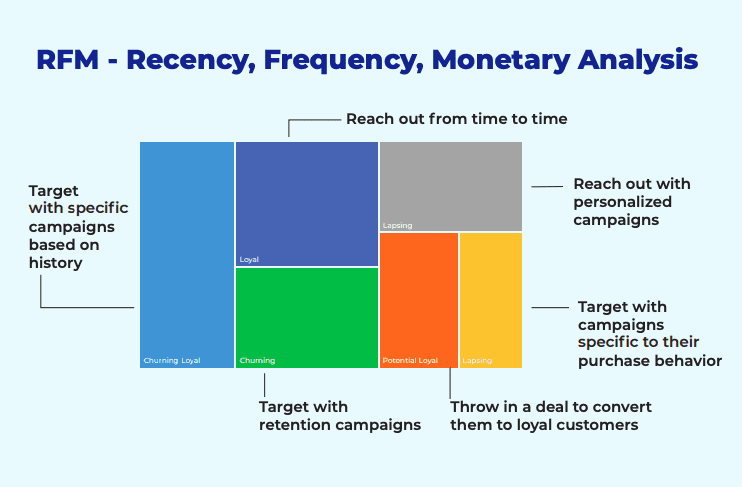
During our latest flagship event, GrowthAsia, we invited experts to share their thoughts on segmentation and its role in B2C personalization. This panel included industry leaders from top brands like OVO, KapanLagi Youniverse, Kredivo, Kompas Gramedia, and Amar Bank.
Here are a few takeaways for consumer brands:
- While implementing advanced segmentation, take your customers’ preferences and behavioral patterns into consideration. Focus on year-on-year aggregated consumer data, preferences on a granular level, repeat behavior, purchase drivers, incentives resonating with the audience, and preferred communication channel.
- For advanced segmentation, look at the user’s predictive lifetime value. To run a targeted campaign, look at the user journey and work backward depending on the business targets you are trying to achieve.
- Transparency with users is key and has to be embedded in the DNA of every organization. When it comes to managing the thin line between personalization and privacy, GDPR works as the gold standard.
👉 You can read more about this session here or watch the recording below:
Impact of B2C Personalization on North Star Growth Metrics
1. Industry: E-commerce; Goal: Purchases
Landmark Group, one of the largest retail brands in the Middle East, Africa, and India, used personalization in the form of product recommendations during the White Wednesday Sale 2020. The team leveraged personalized push notifications to attract customers to the app and used personalized in-app interstitials to increase engagement.
The CRM team at Landmark Group created advanced user segments based on the customers’ behavior in the app, such as:
- Customers who have already opted in to receive push notifications, but have been inactive. The team sent White Wednesday specific communication to highlight the offers in the upcoming sale to this segment.
- Customers who have opted in to receive push notifications and have been active. The team sent targeted communication to promote the use of the ‘wishlist’ feature within the app, inform them about slashed prices, and the option of gifting.
This approach of segmenting customers based on their actions and sending them personalized communication resulted in a 56% uplift in purchases and a 65% increase in retention rate!
👉 Check out how Landmark Group implemented personalization here
2. Industry: Edtech; Goal: Conversion
OnlineTyari, India’s top test preparation platform, implemented omnichannel personalization to improve conversions. The team orchestrated user journeys and took into consideration the multiple digital touchpoints – push notifications, emails, and social media advertisements. These journeys started by onboarding a new user, having them take a test, and eventually getting them to sign up for a paid subscription to OnlineTyari’s platform.
The team personalized all communication based on first name, demographics, last activity, and in-app behavior. This approach resulted in a 400% increase in conversions!
3. Industry: Travel & Hospitality; Goal: Click-through Rates
OYO Rooms, the world’s leading chain of hotels and homes, personalized hotel recommendations for their customers to increase the users’ interaction with relevant communication. The team leveraged their customers’ search and booking history to offer the right message at the right time on multiple digital touchpoints.
OYO’s Marketing team used Smart Triggers to send personalized offers and discounts to users based on their app usage. This strategy resulted in 2X higher CTRs on personalized push notifications.
👉 You can read OYO Room’s success story here or watch the video below:
4. Industry: Travel & Hospitality; Goal: Conversions
Previously known as EasyTaxi, Jeeny, one of the fastest-growing ride-hailing services in the Middle East, wanted to offer relevant real-time communication to the customers on new offers and discounts, specific offer codes to loyal users, and more.
The Marketing team at Jeeny considered their customers’ location, frequency of ride-booking, and language preferences to personalize their messages. For example, if a customer frequently booked a ride for a specific route, then they would receive an offer code related to that route in the city. The team also tweaked their messages based on language preference — users with Arabic preference received push notifications in Arabic, and users with English preference received communication in English.
Thanks to this approach, Jeeny witnessed a 20% uplift in quarterly conversions, and over 962K rides were booked after customers received a personalized notification!
👉 Check out the detailed story of how Jeeny improved conversions using personalization here
B2C personalization in the form of product recommendations
In the past, delivering personalized product recommendations was easy. But today’s modern consumers have unique needs and engage with your brands via multiple channels.
How do you offer the same personalized experience to your digital consumers? How can B2C brands communicate personalized recommendations across multiple channels and touchpoints your consumers interact with?
The answer lies in Dynamic Product Messaging.
Here’s a breakdown for different verticals:
1. Banking and Fintech brands
Dynamic Product Messaging, or DPM, helps banks deliver high-value financial advice. DPM maps consumer attributes with your bank’s product catalog by understanding behavior, preferences, and financial history.
Once the attributes and product portfolios are mapped, you will be able to forecast the right product recommendations for every customer. Learn more in this video below:
👉 Know how Banking and Fintech brands can leverage MoEngage here
2. E-commerce and Retail brands
Personalized recommendations are at the heart of any retail business. Shoppers preferring buying from brands that “get them.”
But billions of unique preferences can make personalized recommendations at scale tough. Here’s how your online shopping brand can do it with DPM:
👉 Learn how E-commerce and Retail brands can leverage MoEngage here
DPM assists your retail brand map each shopper’s attributes with your product catalog. With these mapped attributes and product portfolios, you will be able to orchestrate rich product recommendations. Each campaign will have auto-generated, personalized messages delivered to the shoppers at the right micro-moment on the channel of their preference.
How can B2C Marketers personalize web experiences?
With the increasing adoption of digital platforms by consumers, it is equally important to personalize your website with relevant communication and messaging.
Web Personalization helps you create unique experiences for your customers based on how they interact with your website and the information they have provided. This enables B2C Marketers to run dynamic campaigns with personalized content for each unique visitor and boosting website engagement.
Marketers can tailor experiences for website visitors based on their attributes and behavioral data, deliver seamless and consistent experiences across the user’s purchase path, and enable users to continue from where they last dropped off by creating customized home page banners.
Here’s how verticals can personalize website experience for their customers:
Banking and Fintech brands
The way consumers interact with banking and financial services has evolved rapidly in the near past.
While digitization has transformed the banking industry, how do you provide your users a digital experience that matches or exceeds the high-touch, personalized service that in-person banking offers? Check out the video below to get the answer:
👉 Know how Banking and Fintech brands can leverage MoEngage here
E-commerce and Retail brands
Today, shoppers expect personalized experiences at every stage in their journey. And if you’re running an online store, you can easily personalize web experiences using integrations.
For example, our no-code, one-click integration with Shopify can help you trigger personalized recommendations and reduce cart abandonment by triggering automated web push and on-site messaging campaigns.
Want to learn more about B2C Personalization?
Having worked with multiple consumer brands over the past years, we at MoEngage have built a learning resource, the #GROWTH Academy, for everything related to B2C Marketing – from acquisition to engagement to retention to monetization.
We’ve accumulated a massive amount of information, tips, strategies, and thoughts from industry leaders about B2C Personalization. You can check them all out here.
#GROWTH Academy is built for Product, Growth, and Marketing functions to learn and get officially certified from the very best. If you haven’t already, you can enroll yourself and start your courses by clicking on the image below:









